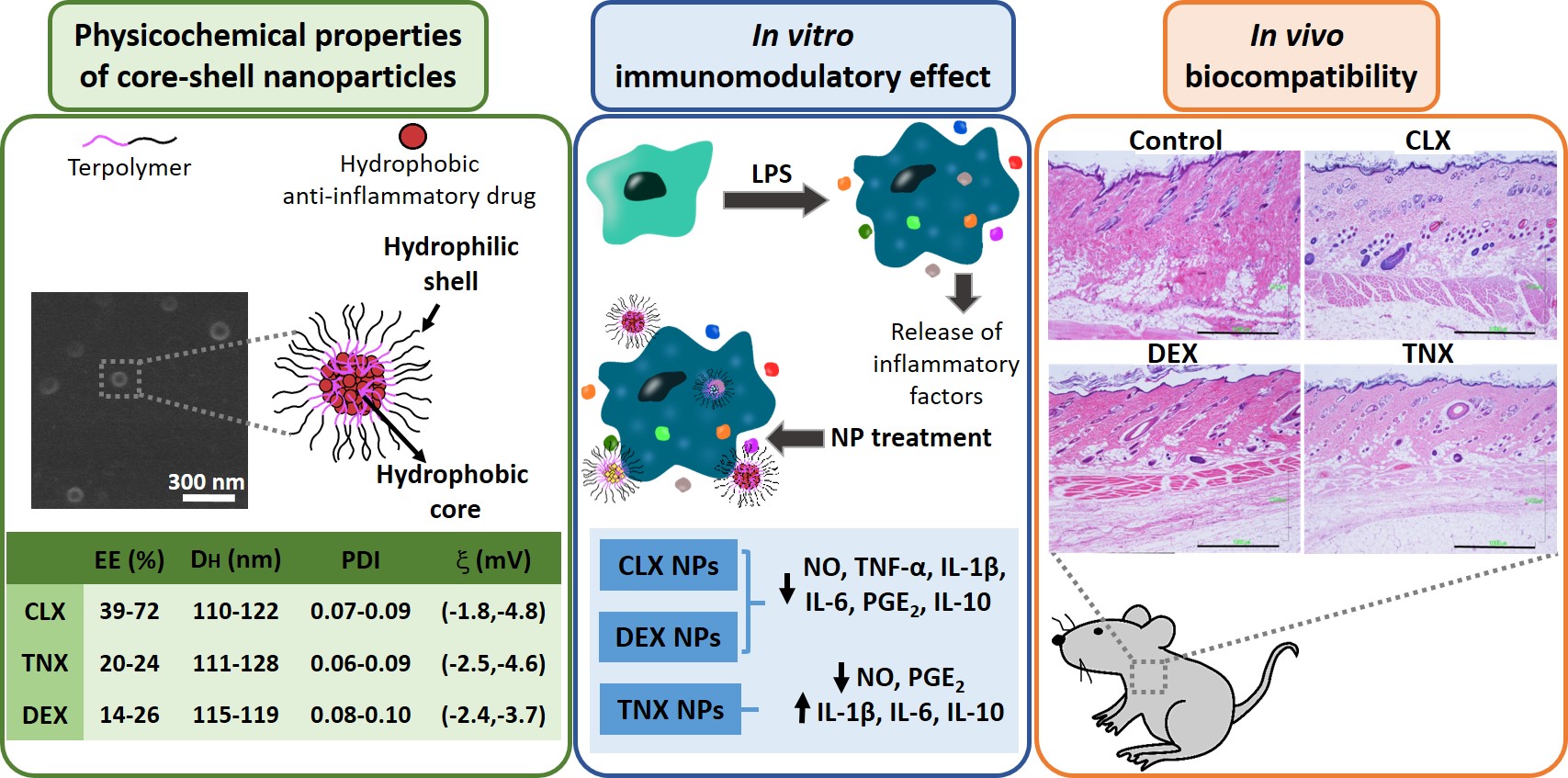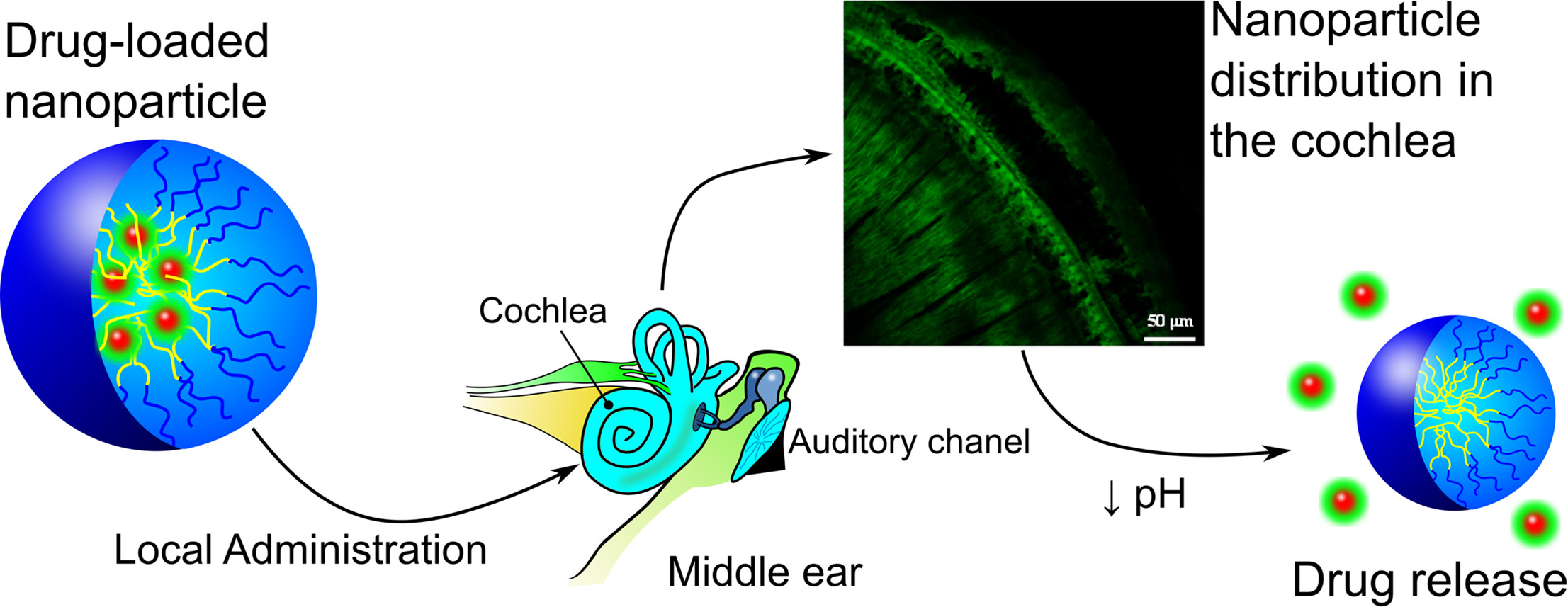The first-line treatment of osteoarthritis is based on anti-inflammatory drugs, the most currently used being nonsteroidal anti-inflammatory drugs, selective cyclooxygenase 2 (COX-2) inhibitors and corticoids. Most of them present cytotoxicity and low bioavailabil-ity in physiological conditions, making necessary the administration of high drug con-centrations causing several side effects. The goal of this work was to encapsulate three hydrophobic anti-inflammatory drugs of different natures (celecoxib, tenoxicam and dexamethasone) into core-shell terpolymer nanoparticles with potential applications in osteoarthritis. Nanoparticles presented hydrodynamic diameters between 110 and 130 nm and almost neutral surface charges (between −1 and −5 mV). Encapsulation efficien-cies were highly dependent on the loaded drug and its water solubility, having higher values for celecoxib (39–72%) followed by tenoxicam (20–24%) and dexamethasone (14–26%). Nanoencapsulation reduced celecoxib and dexamethasone cytotoxicity in human articular chondrocytes and murine RAW264.7 macrophages. Moreover, the three loaded systems did not show cytotoxic effects in a wide range of concentrations. Celecoxib and dexamethasone-loaded nanoparticles reduced the release of different inflammatory medi-ators (NO, TNF-α, IL-1β, IL-6, PGE2 and IL-10) by lipopolysaccharide (LPS)-stimulated RAW264.7. Tenoxicam-loaded nanoparticles reduced NO and PGE2 production, although an overexpression of IL-1β, IL-6 and IL-10 was observed. Finally, all nanoparticles proved to be biocompatible in a subcutaneous injection model in rats. These findings suggest that these loaded nanoparticles could be suitable candidates for the treatment of inflammatory processes associated with osteoarthritis due to their demonstrated in vitro activity as reg-ulators of inflammatory mediator production.
pH-sensitive polymeric nanoparticles with antioxidant and anti-inflammatory properties against cisplatin-induced hearing loss
Polymeric nanoparticles (NP) based on smart synthetic amphiphilic copolymers are used to transport and controlled release dexamethasone in the inner ear to protect against the ototoxic effect of cisplatin. The NP were based on a mixture of two pseudo-block polymer drugs obtained by free radical polymerization: poly(VI-co-HEI) and poly(VP-co-MVE) or poly(VP-co-MTOS), being VI 1-vinylimidazole, VP N-vinylpyrrolidone, and IBU, MVE and MTOS the methacrylic derivatives of ibuprofen, α-tocopherol and α-tocopheryl succinate, respectively. The NP were obtained by nanoprecipitation with appropriate hydrodynamic properties, and isoelectric points that matched the pH of inflamed tissue. The NP were tested both in vitro (using HEI-OC1 cells) and in vivo (using a murine model) with good results. Although the concentration of dexamethasone administered in the nanoparticles is around two orders of magnitude lower that the conventional treatment for intratympanic administration, the NP protected from the cytotoxic effect of cisplatin when the combination of the appropriate properties in terms of size, zeta potential, encapsulation efficiency and isoelectric point were achieved. To the best of our knowledge this is the first time that pH sensitive NP are used to protect from cisplatin-induced hearing loss by intratympanic administration.
Polymeric nanoparticles loaded with dexamethasone or α-tocopheryl succinate to prevent cisplatin-induced ototoxicity
The aim of this work is the development of highly protective agents to be administered locally within the middle ear to avoid cisplatin-induced ototoxicity, which affects to 100% of the clinical patients at ultrahigh concentrations (16 mg/kg). The protective agents are based on polymeric nanoparticles loaded with dexamethasone or α-tocopheryl succinate as anti-inflammarory and anti-apoptotic molecules.
Dexamethasone and α-tocopheryl succinate are poorly soluble in water and present severe side effects when systemic administered during long periods of time. Their incorporation in the hydrophobic core of nanoparticles with the appropriate hydrodynamic properties provides the desired effects in vitro (lower cisplatin-induced toxicity, decreasing of caspase 3/7 activity, and lower IL-1b release) and in vivo (reducing the hearing loss at the local level). The local administration of the nanoparticles by bullostomy provides an adequate dose of drug without systemic interference with the chemotherapeutic effect of cisplatin.



